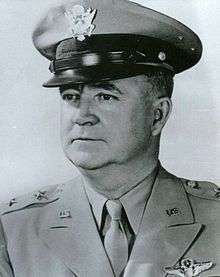John F. Curry
Major General John Francis Curry (April 22, 1886 – March 4, 1973) was the first national commander of the Civil Air Patrol, the United States Air Force Auxiliary. He was also a major general in the United States Army Air Corps.
John F. Curry | |
|---|---|
 | |
| Birth name | John Francis Curry |
| Born | April 22, 1886 New York City, New York |
| Died | March 4, 1973 (aged 86) Colorado |
| Place of burial | |
| Allegiance | |
| Service/ | |
| Years of service | 1904–1945 |
| Rank | |
| Service number | 0-2353 |
| Commands held | Ellington Field Bombing School, Commandant, Air Corps Tactical School, Maxwell Field, Al, Commanding Officer of Hamilton Field, Ca, Commanding General, Northwest Air District and Second Air Force, Spokane, Wash |
| Battles/wars | Pancho Villa Expedition World War I World War II |
| Awards | Distinguished Service Medal Legion of Merit Legion of Honor Ordre de l'Étoile Noire |
| Other work | National Commander, Civil Air Patrol |
Biography
Curry had learned to fly in time to accompany General John J. Pershing's expedition to Mexico. Later, during World War I, he served as Chief of Staff of the Air Service of the Second Army in France, under Col. Frank P. Lahm. On October 26, 1918 while serving as an observer in a 135th Aero Squadron airplane, the DH-4 was shot down by anti-aircraft fire; he and his pilot escaped capture. On November 3, 1918 while still serving as an observer, his plane-along with an aircraft of the 168th Aero Squadron-destroyed a German observation balloon.[1]
In late 1941, there was significant interest by civilian pilots to assist the U.S. military. However, in Washington, D.C., those in authority scoffed at the idea that a group of non-military aviators could provide any such assistance. Despite these misgivings, the Civil Air Patrol was formed as a part of the United States' home defense needs. Curry, an Army Air Corps officer, was selected as its first national commander. As such, he was the nation's only acting general in command of a civilian army. He served in this capacity from December 1941 to March 1942.
Founded as a volunteer organization, the Civil Air Patrol conducted patrols over coastal waters in search of enemy submarines and naval activity. As it was not a government-sponsored plan to provide free flight training, each individual had to pay for their own flying time.
Part of the reason for the founding of the Civil Air Patrol was to keep aviation from being put aside entirely during the war. As Gen. Curry stated, "Without such a plan [as Civil Air Patrol], there might be no private aviation for the duration of the war; with such a plan, there is a chance that private flying may continue and develop." Under Curry's guidance, wings were formed in every state. He helped mobilize 100,000 private pilots for non-combatant service; thus freeing military pilots for wartime duty.
There was no discrimination because of one's gender. Individual ability, experience and past records were the main criteria for selection. In Curry's words, "There must be no doubt in the minds of out gallant women fliers that they are needed and, in my opinion, indispensable to the full success of the Civil Air Patrol organization. A great part of the progress made in organizing civilian aviation under Civil Air Patrol has been due to the volunteer help given by women flyers." Although he only served a few months as national commander, Gen. Curry's organizational skills were influential in determining the future growth of the Civil Air Patrol.
Originally, the Civil Air Patrol was given the opportunity to prove itself for a 90-day test period. Success in deterring German U-boat attacks on merchant vessels encouraged the USAAF and USN to support the Civil Air Patrol's coastal patrol mission, among others. After the end of World War II, the Civil Air Patrol continued to serve the nation in performance of dangerous missions. The Colorado Wing, Civil Air Patrol, and Colorado State Director of Aeronautics, headed now by retired Maj. Gen. John F. Curry, conducted light plane surveys through the rugged Colorado Rocky Mountains. Where more than 50 peaks have an elevation of greater than 14,000 feet (4,300 m), scores of flying individuals lost their lives due to unpredictable winds. As a result of Curry's direction, maps of safe flying routes were developed by Colorado Civil Air Patrol personnel.
The first Civil Air Patrol cadet achievement, the General J. F. Curry Achievement, is named in his honor.
Decorations
 | |||
| USAF Command Pilot wings | ||||||||||||||||
| 1st Row | Army Distinguished Service Medal | Legion of Merit | ||||||||||||||
|---|---|---|---|---|---|---|---|---|---|---|---|---|---|---|---|---|
| 2nd Row | Mexican Service Medal | World War I Victory Medal | American Defense Service Medal | American Campaign Medal | ||||||||||||
| 3rd Row | Asiatic-Pacific Campaign Medal with one service star | World War II Victory Medal | Chevalier of the Legion of Honor (France) | Officer of the Ordre de l'Étoile Noire (France) | ||||||||||||
Sources
- Leadership: 2000 and Beyond. I (Second ed.). Civil Air Patrol. June 2004.
- John F. Curry at Generals.dk
- USAF Biographies at Archive.today (archived 2012-07-18)